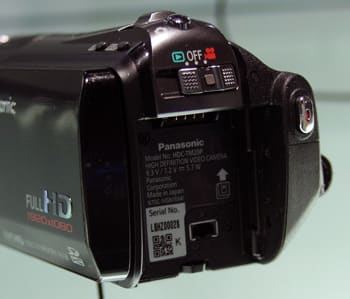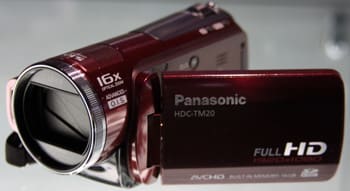Introduction
Audio
We're not yet sure what the final version of the HDC-TM20 will offer for audio controls, but we're interested to see if the offerings are as robust as they were on the HDC-SD9. Last year's model carried with it AGC control and discrete microphone channel levels. The TM20, like the SD9 has no headphone or microphone jack, so you're stuck with what the camcorder can record naturally. But that's still a 5.1-Channel Dolby Digital Surround system and a Zoom Mic. For those breezy days, Panasonic has also included the traditional Wind Cut feature.
Compression & Media
Compression
Video from the Panasonic HDC-TM20 is compressed in the AVCHD format. This is the same format used by most high definition camcorders last year, including Panasonic's entire high def lineup. Without bringing the TM20 into our labs, we can't really judge the video quality, but last year's camcorders seem to suggest that AVCHD is as good as any other format available today. On the TM20, it's more likely to be sensor and lens that bring video quality down.
There are four quality settings to choose from on the Panasonic HDC-TM20, each of which corresponds to a maximum bitrate and a resolution. The HA setting (17Mbps) and HG setting (13Mbps) record in full 1920 x 1080 at either 60i or 24p frame rates. The HX setting (9 Mbps) records full 1920 x 1080, but only at the 60i frame rate. The lowest setting, HE (6 Mbps), has a resolution of 1440 x 1080.
Media
The HDC-TM20 can record to either the internal flash memory or SD/SDHC memory cards. There is also a step-up model, the HDC-HS20, which is identical to the TM20 except it records to an 80GB hard drive or SD/SDHC cards. Hard drives offer higher capacity, but solid state memory is more reliable. On this model and the higher-end HDC-TM300, Panasonic is implementing a 'Relay Recording' feature that will automatically switch to SD card when the internal memory is full.
Editing
This year, Panasonic is emphasizing its new support for the Mac operating system, including compatability with iMovie. Though all the major manufacturers should now be compatible with Macs, Panasonic is one of the few actually publicizing the compatability.
For PC users, the HDC-TM20 also ships with the HD Writer AE 1.0 editing software. This allows you to import video, perform simple editing, and output finished movies to high definition or standard definition DVD or memory cards. We haven't had the opportunity to test out the new software, but we hope that it's more detailed and intuitive than the version of HD Writer that shipped with last year's high definition models.
Manual Controls
Auto Mode
The HDC-TM20 includes a number of features that Panasonic groups into its Intelligent Auto (iA) mode. The star of the show is Panasonic's new AF/AE tracking technology. This feature was one of the driving forces behind Panasonic switching over to touch screen controls. With AF/AE tracking, the user selects a subject on the touch screen and the camcorder will adjust focus and exposure for that subject, even as the subject moves within the frame.
Another part of the iA on the HDC-TM20 is Face Framing, Panasonic's face detection technology. Face Framing can be set to off, primary, and all. When set to 'all,' the camcorder can detect up to 15 faces in all.
The last element of Panasonic's iA technology is the Advanced O.I.S. (Optical Image Stabilization), which can be selected for use with video or still photography.
Low Light Modes The HDC-TM20 includes a drastic low light mode called 'MagicPix' as well as an auto slow shutter mode. Auto slow shutter allows the user to adjust shutter speed down to 1/30 when recording in 60i and 1/24 in 24p.
Scene Modes Another iA feature is Intelligent Scene Selector, which asks the camcorder to analyze the shooting conditions and automatically switches the camcorder into the appropriate scene mode. A scene mode can also be selected manually when not in iA mode. Pick a scene mode based on a common icon or bring up a tool tip to help decipher your choices: Portrait, Snow, Twilight, Sports, Spotlight, Beach, Fireworks.
Zoom **

**
Zoom on the HDC-TM20 is controlled exclusively by the sliding zoom switch on the top of the camcorder. This is the same design as the toggle on all of last year's high def models from Panasonic and isn't the most responsive or finely tuned control. It's also a shame that there's no secondary zoom on the LCD (for two-handed shooting) and, of course, there's no lens ring either.
The sliding zoom switch gets the job done, but we've seen much better controls in the past. When zooming, the LCD provides both the exact zoom ratio (in whole numbers) and a progress bar to give you a sense of where you are in the zoom range.
Zoom Ratio
The Panasonic HDC-TM20 comes equipped with a 16x optical zoom and 40x-1000x digital zoom.
Focus
The HDC-TM20 lacks the manual focus of its higher end cousins, leaving everything to the touch screen. We find touch screen focus adjustment to be inferior to joystick or lens ring focus—in order to change focus, you have to block part of the screen with your finger. And with no viewfinder, the LCD is your only view of the picture that needs to be focused. We expect few users will make use of the manual focus option on the TM20 and those that do will find themselves a little frustrated.
Exposure
On the version of the menus that we saw in action, there was no simple exposure adjustment. (On the high-end models, exposure can be controlled in the Picture Adjust sub-submenu.) It seems surprising that Panasonic would not offer a more user-friendly method of controlling brightness, as independent iris and shutter controls are less accessible to beginners. The HDC-TM20's iA technology also includes a Backlight Compensation feature.
Aperture
Aperture, referred to as 'Iris' by Panasonic, is also adjusted via the touch screen. This control will first gradually open the aperture, then begin increasing gain (once the aperture is fully open). In effect, 'iris' is a combination of aperture and gain control. The aperture range will likely include: f/1.8 (open), f/2.0, f/2.4, f/2.8, f/3.4, f/4.0, f/4.8, f/5.6, f/6.8, f/8.0, f/9.6, f/11, f/14, and f/16.
Shutter Speed
Shutter speed can be independently adjusted via the touch screen from within the Function menu. The default shutter speeds available include: 1/60, 1/100, 1/120, 1/180, 1/250, 1/350, 1/500, 1/750, 1/1000, 1/1500, 1/2000, 1/3000, 1/4000, and 1/8000. The touch screen is an adequate method for adjusting shutter speed, but we wish we didn't have to block the image on the LCD with our fingers.
There are also two settings that can open up a slightly wider range of options for shutter speed. Turning on Auto Slow Shutter will provide you with an additional option of a 1/30th shutter speed. Switching to 24P Digital Cinema mode will add 1/48th as an option. If you have both Auto Slow Shutter and 24P Digital Cinema mode activated, you can access the lowest possible shutter speed of 1/24th.
White Balance
White balance is a fourth option available on the Function menu of the touch screen. Options include: Auto, Sunny, Cloudy, Indoor 1 (incandescent), Indoor 2 (color fluorescent), and Manual. Both the range and method of control is fine for most entry-level consumers.
Gain
Panasonic is the only manufacturer of consumer camcorders to offer a manual gain control. As with the HDC-SD9, gain is part of a larger feature called 'Iris,' which combines aperture and gain to give the user greater control. Unfortunately, combining these two features into one means that you can only increase gain once the aperture is fully opened—you won't be able to increase depth of field and gain at the same time. This kind of limitation isn't present on pro camcorders, but it's fine on entry-level models. The restriction simply prevents users from making their footage too grainy. Available gain settings include: 0dB, 3dB, 6dB, 9dB, 12dB, 15dB, and 18dB.
Color & Image Control
Other Manual Controls
The HDC-TM20 does not have as many manual options as the HDC-HS300, but there are a number of tools that may prove useful for beginners:
Still Features
The HDC-TM20 offers a decent range of still features. If you're looking for a genuine video-still hybrid, you're better off with the HDC-HS300, HDC-TM300, or HDC-HS250. But if you're looking for an entry-level high definition camcorder that can also take still photos, you could do worse than the TM20. Users can do simultaneous still capture while in video mode, or create a 2.1-megapixel still picture from an already recorded video clip. There is a self-timer, flash, and burst shooting.

The flash on the HDC-TM20.
Handling & Use
Ease of Use
The HDC-TM20 is an entry-level high definition camcorder, so consumers expect it to be easy to use—certainly easier to use than the more expensive models. Many will argue that touch screen controls are inherently intuitive, but the accessibility of touch screens depends heavily upon the organization of the menus. For Panasonic, menu design is not a strong suit, so finding options and experimenting with manual controls could be more intuitive.
However, for a high definition camcorder, the TM20 is relatively easy to use. Once you've gotten accustomed to the menu layout, selecting various features isn't terribly difficult. There are things we don't like about touch screens (like greasy fingerprints and lagging interfaces), but we can't deny that they are generally easy to use. There are also a number features that come with Panasonic's Intelligent Auto (iA) mode. At the forefront of the iA technology is the new AF/AE Tracking tool. This was the driving force behind Panasonic's switch to touch screen controls: AF/AE tracking lets you choose a primary shooting target by touching it within the LCD.
Handling
The TM20 is a small product, even among consumer camcorders. Users with larger hands might even find it too small. However, we found that the combination of the hand strap and diminuitive size resulted in a comfortable video experience.
The various buttons and switches are sturdy and responsive. The zoom toggle is the muddiest of the controls and it's disappointing that the LCD contains no secondary controls to facilitate two-handed shooting. The big question, of course, is whether Panasonic's new touch screen will live up to expectations. The model we used was a little finicky and showed a great deal of lag when cycling through menus, but we hope to see these wrinkles ironed out when the final model ships.
Portability
Measuring 64mm x 67mm x 127mm (2.52 x 2.64 x 5.00-inches) and weighing 270g (0.60lb), the HDC-TM20 is essentially the same size as last year's HDC-SD9: that is to say, it is really quite small. This certainly a camcorder you could fit in a purse or a pocket—depending on the size of your pocket. Since the HDC-TM20 can record either to the 16GB internal memory or SD/SDHC cards, it's up to you whether you want to carry around a few memory cards. You will need to tote the AC adapter around no matter where you go, thanks to the DC jack being lodged within the battery chamber. You can't operate the camcorder and charge the battery at the same time.
Battery
Battery life on solid state camcorders tends to be significantly longer than on hard drive, DVD, and tape camcorders—we'll have the final word on battery life when we've gotten the HDC-TM20 into our labs. The biggest disappointment with these Panasonic camcorders is the inability to operate the camcorder and charge the battery at the same time. We're happy to see the AV ports removed from the battery cavity, but we'll still wait with baited breath for Panasonic to remove that DC input as well.

The battery compartment doesn't hold any AV ports, but it still has that pesky DC input hidden in there.
LCD & Viewfinder
The HDC-TM20 again sports a 2.7-inch LCD, which flips out 90 degrees from the body of the camcorder and rotates up to 270 degrees. Resolution is 230,400 pixels, which is about average for a camcorder in this price range. There are two settings that will allow you to alter the display: an LCD Set function for adjusting the color or brightness of the screen and the Power LCD Plus feature for brightening the LCD screen up to two steps. Either setting will alter your perception of what your images look like, so it may interfere with attaining the most accurate shot possible. There's also an Auto Power LCD function, which will automatically adjust the brightness of the LCD, depending on lighting conditions.
The big change this year is Panasonic's switch over to touch screen controls, which will undoubtedly provide users with a collection of greasy fingerprints on the LCD. Unfortunately, these entry-level models do not have a viewfinder.
Menus
Menus are now operated entirely by touch screen. On the high-end models, Panasonic has grouped options into a couple different menus. On the TM20, matters are little improved. The Function menu is still like a quick menu, which brings forward four items that Panasonic expects users will want to switch on the fly. In iA mode, those options are: AF/AE tracking, backlight compensation, faders, and tele-macro. Within the main menu, there is a Record Setup submenu, which holds further submenus. In Manual mode, they become: white balance, shutter speed, iris, and focus. Gratefully, there is no Quick Menu on the TM20—we are glad to be spared from the process of deciphering inscrutable icons.
Playback & Connectivity
Playback
The HDC-TM20 has the same playback mode as last year's HDC-SD9. There is a prominent switch on the back of the camcorder for alternating between record and playback modes. An index screen will appear containing a series of icons representing individually recorded video clips. In order to access stills, select the photo tab from the top of the touch screen. An identical display will appear, only with icons that represent still images.
An Intelligent Scene Detection mode is available, which functions by automatically weeding out all scenes that the camcorder deems are unusable (poor exposure, shaky, out of focus, etc.). This is useful for scenes that were accidentally recorded while walking around, unaware that the Record button was engaged. The Highlight Playback feature will even pick out the most 'interesting' scenes, based on zooming, panning, and the presence of faces. You can also browse for scenes by Date, which will come in handy if you have hundreds of clips to wade through.
Connectivity
The HDC-TM20 offers a decent range of ports, including a couple sturdy covers inside the LCD cavity. We were relieved to see that Panasonic has freed us from the hell of battery compartment AV jacks.
Other Features
Fades To bypass basic post production transitions, you can apply Faders to your video clips. Choose between black or white fade-ins and fade-outs.
Auto Ground Directional Standby (AGS) To avoid accidentally recording the ground as you walk from one place to the next, the HDC-TM20 will automatically power off when it senses a drop from its typical upright recording position.
Pre-Record The HDC-TM20 incorporates Panasonic's Pre-Record function, which will continuously record three second loops of video to an internal cache, in a cyclical process. When the Record button is pressed, the last three seconds of video are tacked onto the beginning of the new clip. This helps you catch a little bit more of those golden moments—even if your trigger finger isn't perfectly honed.
Advanced O.I.S. (Optical Image Stabilization) Part of Panasonic's iA technology is their optical image stabilization, which reduces the effect of hand shake while capturing video or still images.
Conclusion
Panasonic has certainly chosen an interesting amalgam of features for its entry-level high definition lineup. The HDC-TM20 has all of the iA functions (including the new AF/AE Tracking tool) as its more expensive cousins, but it lacks the manual control lens ring and viewfinder. More importantly, the TM20 has a different sensor and lens, which will change what matters most: the video performance.
As more and more consumers are stepping up to the high definition camcorders, we expect a lot of people will be looking at these entry-level camcorders. Until the TM20 makes its way into our labs, we can only hope that Panasonic trimmed down the features without trimming too much from quality.

Photo Gallery
Meet the tester
Vice President of Editorial Management, Kaitlyn oversees the editorial departments of Reviewed.com’s various sites. She has been writing about technology since the turn of the century. Outside of her Reviewed.com home, Kaitlyn is also a theatre director and avid gamer.
Checking our work.
Our team is here to help you buy the best stuff and love what you own. Our writers, editors, and experts obsess over the products we cover to make sure you're confident and satisfied. Have a different opinion about something we recommend? Email us and we'll compare notes.
Shoot us an email